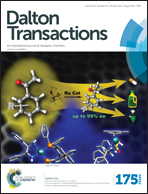Unique trapping of paddlewheel copper(ii) carboxylate by ligand-bound {Cu2} fragments for [Cu6] assembly†
Abstract
The bridging nature of in situ generated hydroxide ions and carboxylates (RCOO−; R = CH3, C2H5, CH2Ph) has been utilized to design a new family of [Cu6] coordination complexes: [Cu6(μ3-OH)2(μ-H2L)2(μ1,1,3-O2CCH3)2(μ1,3-O2CCH3)2(μ-ClO4)2](ClO4)2·H2O (1), [Cu6(μ3-OH)2(μ-H2L)2(μ1,1,3-O2CC2H5)4(μ-ClO4)2](ClO4)2·2H2O (2) and [Cu6(μ3-OH)2(μ-H2L)2(μ1,3-O2CCH2Ph)4(ClO4)2](ClO4)2·2H2O (3). Tetracarboxylate bridged {Cu2} core units are trapped between two ligand-bound {Cu2(μ-H2L)(μ-OH)}2+ subunits forming the [Cu6] complexes. The hexanuclear {Cu6(μ3-OH)2(H2L)2(μ-O2CR)4}4+ cores having six interconnected CuII ions assume a hitherto unknown dumbbell-shaped topology. Detailed characterizations have been done using X-ray crystallography and variable temperature magnetic measurements. For complexes 1–3, the dominant coupling constant (J′) values between carboxylate bridged copper centers are −36.2 to −45.2 cm−1 for short Cu⋯Cu separations of 2.540–2.578 Å. In MeCN solutions all three complexes showed catalytic oxidation of 3,5-di-tert-butyl catechol (3,5-DTBCH2) in air.
![Graphical abstract: Unique trapping of paddlewheel copper(ii) carboxylate by ligand-bound {Cu2} fragments for [Cu6] assembly](/en/Image/Get?imageInfo.ImageType=GA&imageInfo.ImageIdentifier.ManuscriptID=C6DT00103C&imageInfo.ImageIdentifier.Year=2016)

 Please wait while we load your content...
Please wait while we load your content...